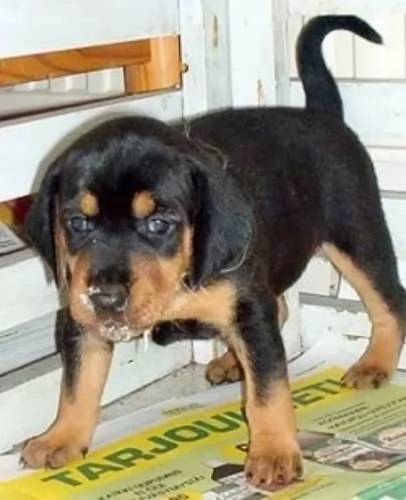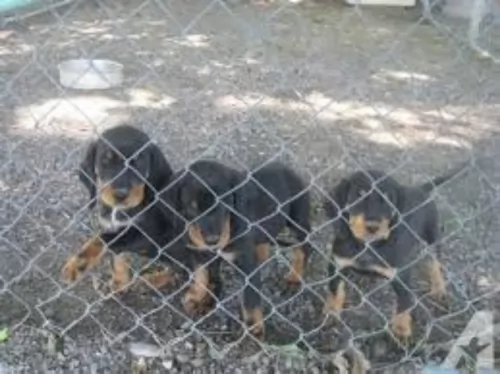 Petzlover
PetzloverHellenic Hound is originated from Greece but Lottatore Brindisino is originated from Italy. Hellenic Hound may grow 15 cm / 5 inches shorter than Lottatore Brindisino. Hellenic Hound may weigh 35 kg / 77 pounds lesser than Lottatore Brindisino. Both Hellenic Hound and Lottatore Brindisino has same life span. Both Hellenic Hound and Lottatore Brindisino has same litter size. Both Hellenic Hound and Lottatore Brindisino requires Low Maintenance.
 Developed in Southern Greece, the Hellenic Hound was bred to hunt hare and is an ancient breed. It is a medium sized breed with strong scent and tracking skills. It is believed to have been in existence for thousands of years. The ancestry of the breed included the Lagonikoi or laconikoi, native to southern Greece in ancient times. The breed was spread by sailors on Greece trading ships and colonization.
Developed in Southern Greece, the Hellenic Hound was bred to hunt hare and is an ancient breed. It is a medium sized breed with strong scent and tracking skills. It is believed to have been in existence for thousands of years. The ancestry of the breed included the Lagonikoi or laconikoi, native to southern Greece in ancient times. The breed was spread by sailors on Greece trading ships and colonization.
Todays Hellenic Hound is found throughout Europe. Kept somewhat isolated by the mountains, the breed was protected from outside breeding and they remained pure for centuries. It is a fearless, smart and hyped up purebred. The Hellenic Hound needs to have a job and if you don’t give him one, he will find one. He is smart and independent which sometimes makes him stubborn. It also takes this dog longer to mature than others, sometime between two and three years. It is not good for first time owners. Today’s hound is still a popular hunting dog and companion animal as well. They are rarely seen outside of the Greek country.
In 1996 the Hellenic Hound was recognized as the first Greek dog breed into the FCI. They are not recognized by the AKC. Its numbers continue to decline.
The Lottatore Brindisino, whose native name is Cande da Marcellaio, is a large molosser type dog which hails from Brindisi, Italy.
He is a rare dog, courageous and effectively used as a herding dog too – to watch over cattle.
When you see him, all hulky and muscular, you realize that its because this is a breed of dog that has been used for fighting.
The dog was specially created by selectively breeding certain dogs such as the Rottweiler, Pit Bull and Cane Corso. The breed has never been standardized or recognized by any major kennel clubs, and is fairly unknown outside of Italy.
 Today’s Hellenic Hound is not a big dog but rather very average or medium. It is an athletic dog and looks like it. It has a balanced body with a deep chest and thick neck. It has medium height legs that are strong and muscular with paws that are prepared for the terrain it always works on. Its coat is short and tight. The colors of the Hellenic Hound are black with tan or white on the chest. Their heads are noble and rounded with a rectangle shaped muzzle. They have v shaped, long ears and round eyes. Their toe nails are black and so is their nose. It has excellent scent glands, very quick responses, speed and stamina. Their tail is thick and tapers off.
Today’s Hellenic Hound is not a big dog but rather very average or medium. It is an athletic dog and looks like it. It has a balanced body with a deep chest and thick neck. It has medium height legs that are strong and muscular with paws that are prepared for the terrain it always works on. Its coat is short and tight. The colors of the Hellenic Hound are black with tan or white on the chest. Their heads are noble and rounded with a rectangle shaped muzzle. They have v shaped, long ears and round eyes. Their toe nails are black and so is their nose. It has excellent scent glands, very quick responses, speed and stamina. Their tail is thick and tapers off.
The Lottatore Brindisino is a medium sized Molosser dog, robustly built, muscular and with large shoulders and chest.
He stands at 60-70cm in height and weighs approximately 40 – 55kg. The head is large, the nose mostly back, and traditionally the tail ad ears have been cropped to avoid injuries during dog fights. In more recent years, the ears and tail are left, so that the ears are medium length and floppy and the tail long.
The coat of the dog is short and dense and found in a number of different colors such as fawn, black or brindle.
The Cane Lottatore Brindisino is a strong looking dog and is also referred to as the Brindisi Wrestler Dog. Today it is a popular watchdog in Italy.
Strong-willed and somewhat aggressive, the Brindisi isn’t looked upon as a family companion. He is also a dog that is going to need plenty of exercise, and training and socialization will be a must for this dog who is loyal to his owner and other human family members but doesn’t extend a friendly paw to strangers. This actually makes him a good watchdog.
He is also aggressive towards other dogs and because of this aggressive side of him, he isn’t recommended as a dog to have around small children.
 yes, they are very fond of children as long as they are carefully socialized.
yes, they are very fond of children as long as they are carefully socialized.
Great hunter, stamina ,scent, voice
He needs to have a yard or land. He doesn’t do well in apartments.
The breed is very intelligent and can be very trainable. However, they can also be stubborn and that makes training harder.
Like many dogs who have a mix of breeds involved with their development, you can’t be 100% sure of the dogs character.
The Lottatore Brindisino is a mix of Rottweiler, Pit Bull and Cane Corso. He has been used as a fighting dog, and while he can be a loyal, devoted pet to his owner, he does have aggression issues and would not be regarded as a good pet choice for first time dog owners and those with small children.
Then again, a dog’s personality depends a lot on the way he is raised and the type of owners he has and the way he is socialized.
 The Hellenic Hound is a fairly healthy breed having been isolated on the Island of Greece for the most part. They are susceptible to:
The Hellenic Hound is a fairly healthy breed having been isolated on the Island of Greece for the most part. They are susceptible to:
Could be hips, elbows or knees. If untreated can lead to lameness or inability to walk.
Causes joint pain and can cause lameness or inability to walk.
Can be fatal if not treated immediately. To avoid it don’t feed a large meal before or after exercise.
Can be a variety of things that occur during the hunt.
Need to keep the ears clean and dry in order to avoid infections.
The Lottatore Brindisino is a muscular, heavily set dog, and care must be taken that puppies, of which this breed can have 5 – 8, don’t grow too quickly. Strenuous exercise is never recommended for puppies below the age of 1, so as to avoid pressure on the soft, young bones.
Other health issues to watch for include panosteitis, an inflammatory condition of the bones as well as skin allergies and lymphoma.
Painful inflammation occurs in the leg bones and cause lameness which can occur suddenly. It’s a condition that affects young dogs that grow too quickly.
Speak to your vet about how to avoid this with your puppy. Affected dogs are usually between 2 and 18 months of age. A typical symptom of this illness is a sudden painful lameness of any of the legs. It’s time to get your pet to the vet because he will certainly require pain control meds.
 Feed the puppy 2-3 times a day a total of 2 cups
Feed the puppy 2-3 times a day a total of 2 cups
Feed the adult twice a day a total of 2-3 cups
The Hellenic Hound has excellent stamina, speed and scenting ability.
This is a very active, athletic dog that needs to work and needs exercise. He is powerful, quick and has great endurance. It thrives on hunting but will need other activities on the days it doesn’t hunt. It needs a yard or land to play in. Agility, Field Trials, tracking, hunting and fly ball are all activities the Hellenic Hound will enjoy.
With his short coat, the Lottatore Brindisino is looked upon as fairly low maintenance and easy to groom. A good brush-down twice a week will remove loose hairs from this moderate-shedding dog. While you brush him, run your hands over his body to feel for any unusual lumps and to also check him over for fleas and ticks.
Other grooming chores for this Molosser type dog of yours is to check inside his ears for redness. The inside of his ears, particularly with floppy-eared dogs, don’t always get enough air to them, and they become damp. With wax and dirt, inside the ears is a breeding place for bacteria.
The inside of the ears need to be kept clean and dry. His teeth will also need to be cleaned 2 or 3 times a week and his nails clipped.
If you don’t have the time to keep up with your pet’s grooming needs, there are professional dog groomers who will do all of this very important grooming for you.
The Lottatore Brindisino is a strong, muscular dog who will require a high protein diet to remain healthy. If you feed him a commercially manufactured dog food, make sure its a quality one, packed full of vitamins and minerals as opposed to preservatives, colorants and fillers found in the low quality brands.
These dog foods also don’t satisfy your pet and he wants to eat more and can then battle with obesity. This is not good news as obesity puts a dog at risk of developing hip dysplasia.
Follow the feeding instructions on the food packaging. If you’re in any doubt about what to feed your Lottatore Brindisino, speak to a dog expert or your vet. If you are feeding your dog a homemade diet, that is excellent news for your pet. Food such as cooked chicken, brown rice or pasta and raw and cooked vegetables mixed into his dry kibble will be excellent for him. Also add in some raw meat to his kibble from time to time.
Such a diet, simple, tasty and nutritious, is complete and balanced. Make sure that he always has a bowl of fresh, cool water at his disposal. Wash out the bowl and keep things clean for your pet.
Provide your pet with a nice, comfortable, warm, dry bed.
When outdoors, make sure your pet has access to a shady spot out of the sun.
Make sure he has shelter away from rain.
Make sure you exercise your pet and that you interact with him. Dogs are social creatures.